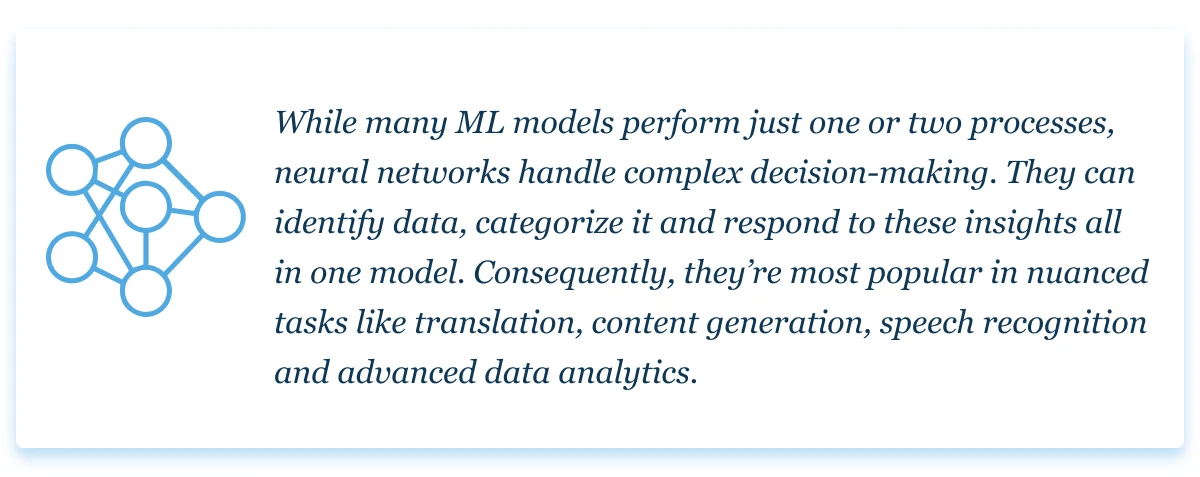Machine learning (ML) is one of, if not the most, disruptive technologies of the modern era. Despite its prevalence, many still struggle to pinpoint a precise machine learning definition or differentiate it from similar technologies.
This technology has grown so quickly that it’s become a buzzword in many circles. As such, most people are already familiar with the term and have a general idea of what it is but lack a deeper, more accurate understanding. That can make it challenging to capitalize on all this innovation’s benefits. Here is a comprehensive introduction to machine learning to help fill that gap.
What is machine learning?
Any successful machine learning project starts with understanding what ML means. Machine learning is the concept of teaching intelligent algorithms to learn from data. In this way, it replicates how human intelligence works, though some models resemble the human brain more closely than others.
The specific steps in machine learning vary between different techniques, but a few factors remain constant. In general, ML models involve three core processes: a way to detect patterns in data, a function to determine this pattern detection’s accuracy, and a method for improving based on the results.
This process of guessing patterns and correcting the model to enable more accurate results is called training. The better data scientists can train the model, the more reliable it will be throughout the machine learning life cycle. While this phase is crucial in all ML applications, it can take several forms.

Source: Unsplash
AI and machine learning: What’s the difference?
It’s important to distinguish between artificial intelligence (AI) and machine learning before going further. While many people use these terms interchangeably, AI and machine learning are not the same thing, though they are related. In short, machine learning is a specific type of AI.
All machine learning models are AI models, but not all AI is machine learning. The key difference is in the word “learning.” AI, in a general sense, refers to computer systems that function similarly to human thinking. Machine learning is unique because these systems learn to do things without explicit programming.
As small as that distinction may seem, it’s an important one. It means the machine learning development process looks different from conventional AI programming. Instead of teaching ML models to complete a task directly, data scientists teach them to learn how to complete it on their own.
Why is machine learning important?
The advent of machine learning in AI is significant for several reasons. When AI algorithms learn to accomplish tasks instead of following straightforward programming, they become much more versatile. In many cases, they can find their own way to do things that are more efficient or accurate than what human programmers could think of.
This advantage is particularly helpful in data analytics. Machine learning can find patterns in huge datasets that humans would miss. This pattern recognition enables the personalization that 71% of consumers today expect from businesses and opens the door to process optimization companies would overlook otherwise. Machine learning technologies do more than automate tasks that humans once did. Their analytical capabilities enable them to do things that would be almost impossible without them.

Source: Unsplash
Predictive analytics is a great example. In this field, ML models can accurately predict the future by analyzing past trends. As a result, humans have more time and insight than ever to prepare for incoming changes, whether that applies to medical treatment, supply chain operations or emergency responses.
How does machine learning work?
Learning how machine learning works is crucial to having machine learning explained thoroughly. Choosing the right machine learning solutions is easier when businesses understand their inner workings. With that in mind, here’s how the three main types of machine learning work.
Supervised machine learning
Supervised models are the most basic type of machine learning. These algorithms train on labeled datasets — data humans have identified and labeled for them. The model then uses these examples to apply the same labels to new information.
Because supervised machine learning relies on structured data and involvement from data scientists, it’s a more involved process than other methods. However, it’s also easy to make these models accurate. That ease of implementation makes them a good fit when businesses already partner with a custom cloud services partner to structure their data.
Common use cases for supervised machine learning models include image classification, spam filtering and sales forecasting. These examples highlight that this method is best for applications involving well-defined categories and straightforward decision-making.
Unsupervised machine learning
Whereas supervised learning relies on labeled datasets, unsupervised machine learning uses unlabeled data. These unstructured datasets mean ML models may include more errors before optimization, but they minimize human involvement, which improves efficiency. Up to 90% of all data is unstructured, so not having to label and organize datasets saves a lot of time.
Unsupervised machine learning works by looking for patterns in unstructured input data. Once it recognizes a few distinct categories, it can create and assign its own labels to this information. As a result, it may provide higher accuracy than supervised models and can find trends and insights human data scientists may miss.
This type of machine learning is ideal for tasks where businesses don’t know the best way to classify their data. Popular use cases include customer segmentation, predictive maintenance and generative AI.
Some machine learning approaches combine supervised and unsupervised learning in a process called semi-supervised learning. These methods label some data but not all, offering a balance between flexibility, costs and accuracy. Natural language processing (NLP) models typically use this approach.

Source: Unsplash
Reinforcement learning
Reinforcement learning is the final major machine learning category. These ML models use unstructured data, like unsupervised algorithms. However, they don’t necessarily categorize this information. Instead, they attempt to achieve a goal through trial and error.
Reinforcement learning is less concerned with understanding a dataset and more focused on developing a desired behavior. As such, it does not use sample data in its training datasets. Instead, it teaches itself what’s right and wrong by rewarding desired outcomes or punishing undesired ones.
The machine learning development process is more complicated in reinforcement learning than other methods. However, the resulting algorithms can perform complex tasks well. The AI model that won “Jeopardy!” by a wide margin in 2011 relied on this method. Self-driving cars and recommendation engines also use reinforcement learning.
Types of machine learning models
Now that it’s clear how machine learning works, specific machine learning model types are easier to understand. There are many machine learning techniques within the broader categories of supervised, unsupervised, and reinforcement learning, each with unique pros and cons. Here are five of the most significant.
Linear regression
Regression models are some of the most common types of supervised learning, and linear regression is the most basic of these algorithms. As the name implies, these models identify linear relationships between data points. Once they determine these relationships, they can predict simple outcomes.
Linear regression is best at modeling the outcome of direct, one-to-one relationships. Demand forecasting is a good example. A winter apparel company could use linear regression to alert officials of incoming demand spikes as the weather gets colder, which historically coincides with higher sales.

Source: Unsplash
The biggest advantage of these machine learning systems is that they’re simple. As such, businesses can implement them easily without much experience, which is important in light of how 50% of AI positions may go unfilled in the future. However, real-world relationships aren’t always black and white, so linear regression is not always reliable.
Decision trees
Decision trees are another type of supervised machine learning. These models resemble flow charts and analyze data through a series of questions to narrow down the best result. That could mean finding the most specific category to file a data point in or determining the most likely outcome of a situation.
Like linear regression, decision trees can predict future outcomes, but they do so considering a wider range of conditions. This makes them a popular choice for sales forecasting or supply chain analytics. Decision trees also make good classification algorithms ideal for machine vision or fraud detection.
Decision trees are often more reliable than linear regression and can handle more complex tasks. It’s also easy to see how they arrive at their outcomes, which helps with regulatory compliance and fine-tuning the model. Still, they’re prone to overfitting — where the model fails to generalize what it’s learned outside of its training data — and are sensitive to small variations in their data.
Random forests
One way to solve the overfitting problem is to use a random forest. These machine learning models combine multiple decision trees to arrive at an answer with greater confidence. Depending on the type of task, the outcome will either be the average across each decision tree output or the common result.
Random forests have many of the same use cases as decision trees but are better for more complex versions, given their higher reliability. Sensitive predictive tasks like financial forecasting or high-risk regression tasks like automated diagnoses are popular examples.
The obvious benefit of random forests is that they’re more accurate and less prone to overfitting than decision trees or linear regression. However, this reliability comes at the cost of more time and computing resources. While IT budgets are rising by 6.8% on average, creating room for the necessary processing power, not every organization can afford the resources needed for these models.
Clustering algorithms
Clustering algorithms are some of the most common unsupervised machine learning models. This broad category covers multiple model types that cluster data into groups based on similar characteristics.
Like most types of unsupervised learning, clustering is best for analyzing data when there’s a lot of uncertainty involved. Applications include segmenting customers without predefined groups, detecting suspicious spending patterns, and classifying images.
Clustering algorithms reveal correlations between data points but cannot infer what these relationships mean. As a result, in-depth data analytics may require a more advanced machine learning approach. On the other hand, clustering is a great first step in more complex machine learning life cycles and is useful for detecting anomalies.
Neural networks
Deep neural networks (DNNs), also called deep learning, can use any type of machine learning approach — supervised, unsupervised or reinforcement. What sets these models apart is that they mimic how the human brain works. DNNs use multiple layers of interconnected decision-making algorithms the same way brains use layers of neurons.

Deep neural networks are among the most impressive examples of AI and machine learning. They’re more accurate and versatile than any other method but are among the most expensive and complicated to implement. It often takes considerable time and resources to build and deploy these models.
Machine learning in data science
Machine learning models across these different algorithm types and learning techniques have applications in various businesses. One of the most impactful is using machine learning in data science.
AI and machine learning excel at finding connections between data points that humans may overlook. This technology can also process huge volumes of information in much less time than a human data scientist can. Consequently, machine learning in business analytics is now standard practice in many industries.
ML models can predict customer churn, identify underserved markets, highlight supply chain inefficiencies and more. Businesses today understand that their data is their most valuable resource, but this information is only useful if teams can pull insights from it. Machine learning automates that process to make data science faster and more reliable.
Machine learning in customer service
Customer service is another of the most common machine learning use cases today. Effective customer service is largely a matter of understanding a target audience and anticipating their needs. Machine learning algorithms make both of those goals easier by analyzing client data.
Neural networks can observe patterns in how market niches behave and then tailor actions to each group. AI-powered chatbots are a great example. These bots can respond to users in the way they prefer to communicate and analyze their past actions to predict their needs. Even if the bot must pass the customer to a human representative, this analysis can help the agent know what to expect.
Recommendation engines are another popular way to use machine learning in customer service. Machine learning models can analyze past user behavior to learn what they like or what new things would interest them. They can then make more accurate recommendations, boosting customer loyalty.
Machine learning in marketing
Many businesses use machine learning models for marketing, too. Like customer service bots, these algorithms analyze user trends to learn more about their shopping habits or needs. While humans can perform this kind of research, machine learning does it faster and more accurately.
Clustering algorithms can segment customers based on their social media preferences, buying habits, or demographics to enable more targeted marketing. Machine learning can then act on these clusters to automate more of the marketing journey. That can include generating custom emails, showing different variations of an ad, or offering personalized promotions.
Machine learning can also help craft new marketing campaigns. More than 60% of marketers today plan on using it in their influencer marketing campaigns, mostly to identify partners or determine who to avoid.
Machine learning in security
AI and machine learning are also common in cybersecurity workflows. Security professionals must continuously monitor networks to detect breaches early enough to stop them before they cause much damage. That’s nearly impossible with human teams, but ML makes it possible.
Machine learning can identify suspicious behavior through clustering algorithms. The ML models cluster behaviors it sees often to define normal activity, so anything outside of the norm immediately stands out. Machine learning technologies then alert security workers and contain the account or device in question to stop the attack before it spreads.
On average, these tools save $1.76 million when data breaches occur. Much of these savings stem from the fact that ML can catch attacks earlier, putting a quicker end to the related losses.
Machine learning in self-driving cars
Machine learning is also the driving force behind autonomous vehicles. These complex technologies combine several machine learning systems to safely navigate unpredictable streets.
Machine vision algorithms analyze real-time camera data to identify cars, stoplights, pedestrians and other hazards. Deep neural networks combine this information with sensor readings and GPS data to get a complete picture of the situation and respond appropriately. While this level of nuance is typically something humans are better at than AI, machine learning has the advantage of never getting distracted, tired or drunk.

Source: Unsplash
Distracted drivers killed 3,308 people in 2022 alone. When self-driving cars become reliable enough to handle most driving activities, they could dramatically reduce that number. In this case, machine learning doesn’t just solve business problems — it saves lives.
Risks of ML technology
With the advantages and use cases of machine learning explained, it’s important to consider the potential downsides. As helpful as this technology is, it also introduces some risks businesses must be aware of to use it safely.
Costs and complexity
One of the most common issues businesses face with ML technology is that it can be expensive and difficult to implement. This technology is still new, and training the model can take time, depending on the type of machine learning technique in question. These obstacles can make it challenging for smaller companies to capitalize on this innovation.
There are ways around this issue. While the upfront costs may be high, machine learning often saves money in the long run, so it pays for itself eventually. Businesses can also work with a reliable machine learning consulting partner to right-size their model and streamline training, reducing costs.

Source: Unsplash
Job loss
As with any other kind of automation, AI and machine learning may also raise fears about job losses. Workers may worry that they’ll become more disposable in their employers’ eyes as ML automates more of the work they used to do. Generative AI is particularly disruptive in this regard.
The answer to this problem is largely in how businesses approach machine learning technology. ML is most effective as a complement to human workers, not a replacement. Therefore, employers should view it as a way to help their employees and communicate that they won’t replace them with AI. Training workers to use ML effectively will help by giving them relevant skills.
Bias
In some cases, machine learning introduces bias-related risks. While the models themselves have no intrinsic prejudice, there may be human biases in their training data. As the algorithm learns, it may exaggerate these biases even more than the humans programming it. Amazon infamously stopped an AI project in 2017 because the recruiting algorithm taught itself to be prejudiced against women — the result of training mainly on men’s resumes.
Businesses can address this issue by reviewing their training data to ensure it’s bias-free. Programming ML models to ignore factors that could lead to prejudice can also help. Data science teams should also be diverse and audit the model regularly to catch and fix any signs of favoritism.
Data privacy
Training these models can also raise privacy concerns because the steps in machine learning require so much data. Hackers could target training databases to steal information on multiple people in one attack. Some users may not be comfortable with businesses collecting information on their behavior, either.
The first step is to be upfront with users about data collection and let them opt out. Some laws, like the General Data Protection Regulation, require user consent for collecting information, so this is an important part of compliance. Businesses should also restrict access to training data as much as possible and monitor it to prevent unauthorized access.
Learn more about machine learning systems
At this point, machine learning’s definition, benefits, inner workings, use cases and potential risks should be clear. However, this technology is evolving as new techniques and best practices emerge. Staying on top of these developments is key to using machine learning effectively.
Businesses can see significant improvements from this technology when they understand what machine learning is, how it works and what pitfalls to watch out for. Working with a reliable ML service partner is still necessary, but education is the first step in making the most of machine learning.



